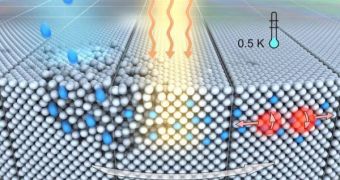Most chemical elements have the ability to become superconductors under given circumstances, when they are subjected to very low temperatures and high pressures, depending on the material. However, until now, researchers failed to endow copper, silver, gold, and germanium with this ability, mostly because of the particular structure that these elements have. Only recently, experts at the German Forschungszentrum Dresden-Rossendorf (FZD) research center managed to create superconducting germanium for the first time, making the semiconductor a feasible option for a number of applications.
Semiconductor materials, such as silicon and germanium, are usually not able to conduct current at very low temperatures, except if they are treated with foreign atoms, in a process known in the industry as doping. Among the most common additions to semiconductors during doping are ions, which are in fact nothing more than charged atoms. Ions are usually inserted in the crystal lattice of semiconductors, where they cause a shift in their physical properties, and allow them to conduct electricity.
During the FZD experiments, the German researchers added gallium atoms to the germanium's crystal lattice, in a proportion of about 6 per 100 atoms. They created a germanium layer that was only sixty nanometers in thickness, and proved that the newly-obtained material could act like a superconductor as a whole, and not just in the parts where the gallium atoms were inserted. The main issue that the team had was how to repair the crystal lattice after the ion bombardment, which usually severely damages it.
They way they did that was by designing a special flash-lamp annealing facility in the laboratory. The way this lamp acts is by heating the lattice within a few milliseconds, repairing it, and maintaining the distribution of gallium atoms within it at acceptable levels. A promising aspect of the new superconductor is the fact that the temperature at which it gets this property, which is now about 0.5 Kelvin, could be increased by tweaking some of the parameters of the production process, such as the doping procedure or the annealing, ScienceDaily informs.

 14 DAY TRIAL //
14 DAY TRIAL //